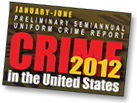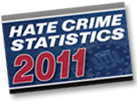Uniform Crime Reports
The Uniform Crime Reporting (UCR) Program was conceived in 1929 by the International Association of Chiefs of Police to meet a need for reliable, uniform crime statistics for the nation. In 1930, the FBI was tasked with collecting, publishing, and archiving those statistics. Today, several annual statistical publications, such as the comprehensive Crime in the United States, are produced from data provided by nearly 17,000 law enforcement agencies across the United States.
Other annual publications, such as Hate Crime Statistics and Law Enforcement Officers Killed and Assaulted, address specialized facets of crime.
Special studies, reports, and monographs prepared using data mined from the UCR’s large database are published each year as well. In addition to these reports, information about the National Incident-Based Reporting System (NIBRS), answers to general UCR questions, and answers to specific UCR questions are available on this site.
- A Word about UCR Data
- UCR Statistics, Their Proper Use (pdf)
- UCR Publication Schedule
- Data Quality Guidelines
- Frequently Asked Questions
- UCR Methods of Quality Control (pdf)
- UCR Reporting Forms
- UCR Electronic and Hard Copy Data Dissemination Standard Operating Procedures (pdf)
Crime in the United States (CIUS) is an annual publication in which the FBI compiles volume and rate of crime offenses for the nation, the states, and individual agencies. This report also includes arrest, clearance, and law enforcement employee data. Use the new online UCR Data Tool to research crime statistics from as far back as 1960.
|
|
Each year’s edition of Hate Crime Statistics presents data regarding incidents, offenses, victims, and offenders in reported crimes that were motivated in whole or in part by a bias against the victim’s perceived race, religion, ethnicity, sexual orientation, or disability.
Note: Although the Uniform Crime Reporting Program applies estimation procedures to account for populations covered by reporting jurisdictions, it does not use any estimation procedures to account for hate crime data from agencies that do not participate in the Hate Crime Statistics Program.
|
|
Law Enforcement Officers Killed and Assaulted
The FBI annually compiles data concerning the felonious and accidental line-of-duty deaths and assaults of law enforcement officers and presents these statistics in Law Enforcement Officers Killed and Assaulted (LEOKA). Tabular presentations include weapons used, use of body armor, and circumstances surrounding murders and assaults of officers.
The UCR Handbook outlines the classification and scoring guidelines that law enforcement agencies use to report crimes to the UCR Program. In addition, it contains offense and arrest reporting forms and an explanation of how to complete them. The handbook also provides definitions of all UCR offenses.
The Automated Data Processing Guidelines for State UCR Programs/Direct Contributors, or ADP Guidelines, provides the programming requirements for submitting Summary Reporting System reporting forms in an electronic flat file format.
Cargo Theft Electronic Data Submission Specifications provides the programming requirements for submitting Cargo Theft reporting forms in an electronic flat file format.
The publication below presents supplemental UCR statistics auxiliary to those published in Crime in the United States with regard to age-specific arrest rates and race-specific arrest rates for 1993-2001.
National Incident-Based Reporting System
In response to law enforcement’s need for more flexible, in-depth data, the UCR Program formulated the National Incident-Based Reporting System (NIBRS). NIBRS presents comprehensive, detailed information about crime incidents to law enforcement, researchers, governmental planners, students of crime, and the general public. The South Carolina Law Enforcement Division conducted the pilot demonstration of this program in 1987. Since then, implementation of NIBRS has been commensurate with the resources, abilities, and limitations of the contributing law enforcement agencies. Although participation grows steadily, data is still not pervasive enough to make broad generalizations about crime in the United States. However, several NIBRS studies and monographs are available on this site that demonstrate the great utility of NIBRS. Data collection and submission guidelines and NIBRS Frequently Asked Questions and NIBRS Incident Specific Questions are available as well to help law enforcement agencies with the implementation of and participation in NIBRS.
If you have trouble accessing any of the Uniform Crime Reports, contact a member of the Multimedia Productions Group by telephone at (304) 625-4995; by fax at (304) 625-5394; or by e-mail at cjis_comm@leo.gov. E-mail data requests cannot be processed unless requesters include their full name, a mailing address, and a contact telephone number.
Note: Although the Uniform Crime Reporting Program applies estimation procedures to account for populations covered by reporting jurisdictions, it does not use any estimation procedures to account for hate crime data from agencies that do not participate in the Hate Crime Statistics Program.









